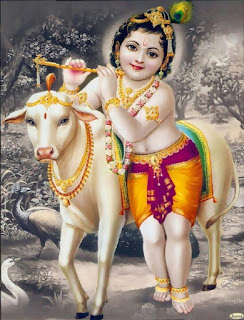Krishna Janmashtami
Krishna Janmashtami (Devanagari कृष्ण जन्माष्टमी), also known as Krishnashtami, Saatam Aatham,Gokulashtami, Ashtami Rohini, Srikrishna Jayanti, Sree Jayanti or sometimes simply as Janmashtami, is an annual celebration of the birth of the Hindu deity Krishna, the eighth avatar of Vishnu.
The festival is celebrated on the eighth day (Ashtami) of the Krishna Paksha (dark fortnight) of the month of Bhadrapad (August–September) in the Hindu calendar. Rasa lila, dramatic enactments of the life of Krishna, are a special feature in regions of Mathura and Vrindavan, and regions following Vaishnavism in Manipur. While the Rasa lila re-creates the flirtatious aspects of Krishna's youthful days, the Dahi Handi celebrate God's playful and mischievous side, where teams of young men form human towers to reach a high-hanging pot of curd and break it. This tradition, also known as uriadi, is a major event in Tamil Nadu on Gokulashtami. Krishna Janmashtami is followed by the festival Nandotsav, which celebrates the occasion when Nanda Baba distributed gifts to the community in honour of the birth.
Lord Krishna
Krishna was the eighth son of Devaki and Vasudeva. Based on scriptural details and astrological calculations, the date of Krishna's birth, known as Janmashtami, is 18 July 3228 BCE and he lived until 18 February 3102 BCE. Krishna belonged to the Vrishniclan of Yadavas from Mathura, and was the eighth son born to the princess Devaki and her husband Vasudeva.
Mathura (in present-day Mathura district, Uttar Pradesh) was the capital of the Yadavas, to which Krishna's parents Vasudeva and Devaki belonged. King Kansa, Devaki's brother, had ascended the throne by imprisoning his father, King Ugrasena. Afraid of aprophecy that predicted his death at the hands of Devaki's eighth son, Kansa had the couple locked in a prison cell. After Kansa killed the first six children, and Devaki's apparent miscarriage of the seventh (which was actually a secret transfer of the infant to Rohini as Balarama), Krishna was born.
Following the birth, Vishnu ordered Vasudeva to take Krishna to Gokul to Nanda and Yashoda, where he could live safely, away from his Uncle Kansa. Vasudeva took Krishna with him and crossed the Yamuna to reach Gokul. There, everyone was asleep; so he quietly kept him there and returned with Yashoda's daughter. Kansa, thinking her to be Devki's eight child, threw her on a stone. But she rose into the air and transformed into Yogmaya (who is Vishnu's helper) and warned Kansa about his death. Then, she disappeared. Krishna grew up in Gokul with his brother, Balram. He then returned to Mathura and killed Kansa with the help of Balram.
Celebrations
Hindus celebrate Janmashtami by fasting, worshipping Krishna and staying up until midnight, and offer prayers at special time when Krishna is believed to have been born. Images of Krishna's infancy are placed in swings and cradles in temples and homes. At midnight, devotees gather around for devotional songs, dance and exchange gifts. Some temples also conduct readings of the Hindu religious scripture Bhagavad Gita.
WATCH KRISHNA JANMASHTAMI SEPCIAL VIDEO SONGS HERE:
**ThanksfulFrom Wikipedia, the free encyclopedia


No comments:
Post a Comment